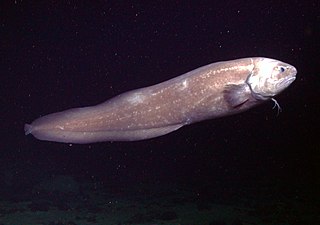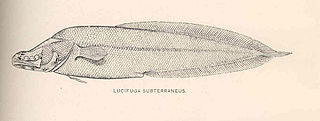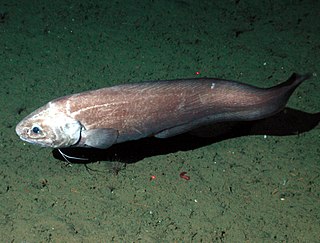Guttigadus globosus, the tadpole cod, is a deepwater fish found in the oceanic islands off New Zealand and in the mid South Atlantic at depths ranging from 1200 to 1600 m.

The cusk-eel family, Ophidiidae, is a group of marine bony fishes in the Ophidiiformes order. The scientific name is from the Greek ophis meaning "snake", and refers to their eel-like appearance. True eels, however, diverged from other ray-finned fish during the Jurassic, while cusk-eels are part of the Percomorpha clade, along with tuna, perch, seahorses, and others.
The pink cusk-eel, Genypterus blacodes, is a demersal species of cusk-eel found in the oceans around southern Australia, Chile, Brazil, and around New Zealand except the east coast of Northland, in depths of 22 to 1,000 metres. Their length is up to 200 centimetres, and they live for up to 30 years. Their maximum weight is 25 kilograms.

Lucifuga is a genus of viviparous brotulas. Most of the species are native to caves and sinkholes in Cuba and the Bahamas; L. inopinata from deep water off the Galápagos Islands is the only exception. The four species rated by the IUCN are all considered vulnerable. The largest species in the genus reaches about 15 cm (5.9 in) in length.

Spectrunculus grandis is a species of Rhizopharyngia ray-finned fish in the cusk-eel family known by the common names pudgy cusk-eel and giant cusk-eel. It is one of two species in the formerly monotypic genus Spectrunculus, the other species, S. crassus, having been differentiated in 2008.

Bidenichthys is a genus of viviparous brotulas.
Bassogigas is a genus of cusk eel from the subfamily Neobythitinae, part of the family Ophidiidae. The generic name "Bassogigas" comes from a combination of two Latin words: bassus, which means "deep" and gigas which means "giant". The species are found in the Indo-Pacific and western Atlantic Ocean.

Brotula is a genus of cusk-eels. It is the only genus is the subfamily Brotulinae.
Brotulotaenia is a genus of cusk-eels. It is the only genus in the subfamily Brotulotaeniinae.

Chilara taylori, the spotted cusk-eel, is a species of cusk-eel found along the eastern coast of the Pacific Ocean where it is found at depths down to around 280 metres (920 ft) from Washington, United States to Ecuador. This species grows to a length of 40.4 centimetres (15.9 in) TL. It is the only known member of its genus.
Glyptophidium is a genus of cusk-eels.
Hoplobrotula is a genus of cusk-eels.
Lamprogrammus is a genus of cusk-eels.

Otophidium is a genus of cusk-eels, part of the subfamily Ophidiinae in the family Ophidiidae. They are found in the western Atlantic and eastern Pacific.
Parophidion is a genus of cusk-eels found in the Atlantic Ocean and the Mediterranean Sea.
Porogadus is a genus of cusk-eels.

Pycnocraspedum is a genus of cusk-eels.

Spectrunculus is a genus of cusk-eels found in the Atlantic and Pacific Oceans.

The band cusk-eel is a fish species in the family Ophidiidae. Widespread in the Western Atlantic from North Carolina, United States, and northern Gulf of Mexico to southeastern Brazil. Absent from The Bahamas. Marine reef-associated tropical demersal fish, up to 30 cm (12 in) long.

Genypterus capensis, commonly known as kingklip, is a species of cusk eel occurring along the Southern African coast from Walvis Bay in Namibia to Algoa Bay in South Africa. It is closely related to Genypterus blacodes from New Zealand. The species grows to a maximum length of 180 cm and a weight of 15.0 kg. It is one of the most popular fish items on South African menus. Despite appearances, it is not closely related to the eels of the order Anguilliformes.












